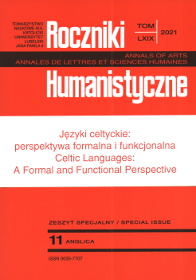Word Order Alignment in Three-Argument Constructions of Irish
Abstrakt
Uporządkowanie linearne w strukturach trójmiejscowych w języku irlandzkim
W artykule zbadano uporządkowanie linearne aktantów aktor (A), temat (T) oraz odbiorca (R) w predykatach trójmiejscowych w języku irlandzkim w oparciu o założenia modelu Role and Reference Grammar. Istnieje szereg czynników, które wpływają na przekład związków semantyczno-syntaktycznych na podstawowy szyk zdaniowy A-T-R. Należą do nich ikoniczność, struktura informacyjna, topikalizacja, rozróżnienie pomiędzy informacją podaną a nową, wpływ różnych hierarchii referencyjnych oraz znaczenie syntaktyczne. Wykazano, że niektóre z nich mają zastosowanie dla danych z języka irlandzkiego. Jeśli temat ma formę zaimka w bierniku, szyk ulega zmianie i w konsekwencji temat występuje po odbiorcy na końcu zdania prowadząc do uporządkowania A-R-T. Postpozycja tematu mającego formę zaimkową wynika z wzajemnych oddziaływań pomiędzy hierarchią rzeczownikową i zaimkową a zasadą wagi syntaktycznej. W gramatyce irlandzkiej istnieje tendencja do umieszczania biernikowego tematu na końcu zdania przy jednoczesnym dodaniu narzuconej niezmienności.
Bibliografia
Bennett, Ryan, et al. “Pronouns and Prosody in Irish.” Proceedings of the XIV International Congress of Celtic Studies, Maynooth University, 1–5 August 2011, edited by Liam Breatnach et al., School of Celtic Studies, Dublin Institute for Advanced Studies, 2015, pp. 19–74.
Bennett, Ryan, et al. “Lightest to the Right: An Apparently Anomalous Displacement in Irish.” Linguistic Inquiry, vol. 47, no. 2, 2016, pp. 169–234. doi.org/10.1162/LING_a_00209.
Birner, Betty J. “Information Status and Word Order: An Analysis of English Inversion.” Language, vol. 70, 1994, pp. 233–259.
Birner, Betty J., and Gregory Ward. Information Status and Non-Canonical Word Order in English. John Benjamins Publishing Company, 1998.
Brown, Cheryl. “Topic Continuity in Written English Narrative.” Topic Continuity in Discourse. A Quantitative Cross–Language Study, Typological Studies in Language 3, edited by Givón Talmy, John Benjamins Publishing Company, 1983, pp. 315–341.
Butler, Christopher S. Structure and Function: A Guide to Three Major Structural Functional Theories. Part 2, John Benjamins Publishing Company, 2003.
Croft, William. Typology and Universals. Cambridge UP, 1990.
Falk, Yehuda. Subjects and Universal Grammar. Cambridge UP, 2006.
Haspelmath, Martin. “Argument Marking in Ditransitive Alignment Types.” Linguistic Discovery, vol. 3, 2005. linguistic-discovery.dartmouth.edu. Accessed 8 Jan. 2020.
Haspelmath, Martin. “Ditransitive Constructions: The Verb ‘Give’.” The World Atlas of Language Structures, edited by Martin Haspelmath et al., Oxford UP, 2005, pp. 426–429.
Hawkins, John A. A Performance Theory of Order and Constituency. Cambridge UP, 1994. Cambridge Studies in Linguistics 73.
Hawkins, John A. “Some Issues in a Performance Theory of Word Order.” Constituent Order in the Languages of Europe, edited by Anna Siewierska. Mouton de Gruyter, 1998, pp. 729–782. Empirical Approaches to Language Typology 20.
Hawkins, John A. Efficiency and Complexity in Grammars. Oxford UP, 2004.
Heine, Bernd, and Christa König. “On the Linear Order of Ditransitive Objects.” Language Sciences, vol. 32, 2010, pp. 87–131. www.researchgate.net/publication/223187020_On_the_ linear_order_of_ditransitive_objects. Accessed 8 June 2020.
Hickey, Raymond. Irish-English: History and Present Day Forms, Studies in English Language. Cambridge UP, 2008.
Levin, Beth, and Malka Rappaport Hovav. Argument Realization. Cambridge UP.
Malchukov, Andrej, et al. Ditransitive Constructions: A Typological Overview. www.researchgate.net/ publication/265423193_Ditransitive_constructions_A_typological_overview, 2007. Accessed 9 June 2020.
Malchukov, Andrej, et al. Studies in Ditransitive Constructions: A Comparative Handbook. Walter de Gruyter, 2010.
Mallinson, Graham, and Barry Blake. Language Typology: Cross-Linguistic Studies in Syntax. North Holland, 1981.
Mulkern, Ann Elizabeth. “Left Right Behind: Irish Pronoun Postposing and Information Structure.” Formal Approaches to Celtic Linguistics, edited by Andrew Carnie, Cambridge Scholars Publishing, 2011, pp. 179–202.
Nolan, Brian. The Structure of Modern Irish: A Functional Account, Discussions in Functional Approaches to Language. Equinox Publishing Company, 2012.
Ó Siadhail, Mícheál. Modern Irish. Cambridge UP, 1989 [1991].
Payne, Doris. L. The Pragmatics of Word Order: Typological Dimensions of Verb-Initial Languages, Mouton de Gruyter, 1990. Empirical Approaches to Language Typology 7.
Payne, Doris. L., editor. Pragmatics of Word Order Flexibility, Typological Studies in Language 22. John Benjamins Publishing Company, 1992.
Payne, Doris. L. “Verb Initial Languages and Information Order.” Word Order in Discourse, edited by Pamela Downing and Michael Noonan, John Benjamins Publishing Company, 1995, pp. 449–486. Typological Studies in Language 30.
Primus, Beatrice. “The Relative Order of Recipient and Patient in the Languages of Europe.” Constituent Order in the Languages of Europe, edited by Anna Siewierska, Mouton de Gruyter, 1997, pp. 421–473. Empirical Approaches to Language Typology 21–1.
Ruhlen, Merritt. A Guide to the Languages of the World. Stanford UP, 1975. Language Universals Project.
Siewierska, Anna. “Syntactic Weight vs. Information Structure and Word Order Variation in Polish.” Journal of Linguistics, vol. 29, no. 2, 1993, pp. 233–265. www.jstor.org/stable/4176234. Accessed 8 Jan. 2020.
Siewierska, Anna. “Word Order and Linearization.” The Encyclopedia of Language and Linguistics. 2nd ed., edited by Keith Brown, Pergamon and Aberdeen UP, 1994, pp. 642–649.
Siewierska, Anna, editor. Constituent Order in the Languages of Europe, Mouton de Gruyter, 1998. Empirical Approaches to Language Typology 21–1.
Siewierska, Anna. “Person Agreement and the Determination of Alignment.” Transactions of the Philological Society, vol. 101, no. 2, 2003, pp. 339–370.
Siewierska, Anna. Person. Cambridge UP, 2004.
Silverstein, Michael. “Hierarchy of Features and Ergativity.” Grammatical Categories in Australian Languages, edited by Robert M. W. Dixon, Australian Institute of Aboriginal Studies, 1976, pp. 112–171.
Stefanowitsch, Anatol, and Stefan Th. Gries. “Givenness and Linear Precedence: A Construction-Grammar Approach.” Paper given at the 2nd International Construction Grammar Conference (ICCG 2), Helsinki, Finland. 6–8 Sept. 2002.
Tallerman, Maggie. “Word Order in Celtic.” Constituent Word Order in the Languages of Europe, edited by Anna Siewierska, Mouton de Gruyter, 1998, pp. 21–46. Empirical Approaches to Language Typology 21–1.
Tallerman, Maggie. “Celtic Word Order: Some Theoretical Issues.” Constituent Word Order in the Languages of Europe, edited by Anna Siewierska, Mouton de Gruyter, 1998, pp. 599–648. Empirical Approaches to Language Typology 21–1.
Van Valin, Robert. Exploring the Syntax-Semantics-Pragmatics Interface. Cambridge UP, 2005.
Van Valin, Robert. “Role and Reference Grammar as a Framework of Linguistic Analysis.” The Oxford Handbook of Linguistic Analysis, edited by Bernd Heine and Heiko Narrog, Oxford UP, 2010, pp. 703–738.
Van Valin, Robert, and Randy LaPolla. Syntax. Cambridge UP, 1997.
Copyright (c) 2021 Roczniki Humanistyczne

Utwór dostępny jest na licencji Creative Commons Uznanie autorstwa – Użycie niekomercyjne – Bez utworów zależnych 4.0 Międzynarodowe.





